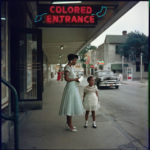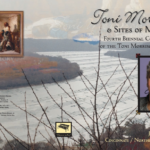Blogpieces for Beloved, Jazz and Paradise
Entering into the emotional dramas and ancestral landscapes of Toni Morrison's novels can be daunting but also exhilarating, and sometimes sobering. Vivid passages can lead us to discover new ways of being in the world as sheer, concrete descriptions rock us
Although she has claim, she is not claimed.In the place where long grass opens, the girl who waited to be loved and cry shame erupts into her separate parts, to make it easy for the chewing laughter to swallow her all away.
This is Morrison's descriptive metaphor for how the character called Beloved disappeared from the house on 124 Bluestone Road.
What do you feel about this young woman after reading this?

You see, I want to know what you think. I want us to be able to share our responses to not only specific image-scenes, as in the above example, but to the emotional arcs of all of the characters; to the landscapes and ancestral territories, to the esthetic experiences of readers encountering dramatic arrangements of the parts of the story, the juxtapositions and oppositions.

Joy Deb /Pexels
That's why I've created what I call "blog-pieces": "blog" to retain the character of a short writing--with images, video links, musical links, and the like--and "pieces" to evoke what are essentially informal, reflective non-fiction pages that speak directly to the reader.
Blogpieces are Organized into 3 Sections:
FOUNDATIONS: Root Blogs, Reader's Participation & Emotional Story Structures
THE HEART OF THE MATTER: Time & Memory, Claiming Geographic Space, Music & Intermediality
LARGER CONTEXTS: More on Aesthetics, Morrison's Intertextuality, & Race and Response-ability
9 BLOGPIECE "CLUSTERS": One way of going through these is to from the upper left to the lower right. But you can browse as you wish! Happy Reading and Responding!
ALTERNATIVE: A Chronological unfolding of the blogs--to see each blog in sequence
“The neighbors seemed pleased when the babies smothered”(21). The opening of one section of Paradise begins with a striking example of a double-voiced, “signifying” discursive style. On a hot day, Mavis had left her two babies in the car—for what she recalled as being just for a few minutes—while she went to the grocery store…
Read More“Great Jazz Musicians have the ability to take different musical perspectives and to integrate them into their own. They symbolize the potential that everyone has to draw on many sources and bring different understandings together in the perspective of their own lives. ” — Arthur Rhames, jazz critic This blogpiece invites you to consider Toni…
Read More“I thought of myself as like the jazz musician—someone who practices and practices and practices in order to be able to invent and to make his art look effortless and graceful. . . . When Keith Jarret plays “Ol’ Man River,” the delight and satisfaction is not so much in the melody itself but in recognizing…
Read More“Sth, I know that woman. She used to live with a flock of birds on Lenox Avenue. Know her husband too. He fell for an eighteen-year-old girl with one of those deep down, spooky loves that made him so sad and happy at the same time he shot her just to keep the feeling going.”…
Read MoreThe “quality of hunger and disturbance that never ends . . . that is what I want to put in my books.” ~ Toni Morrison Specifically here, she is talking about jazz, yet there are many deep-rooted connections between black music and literature that can impact the reading of Morrison’s work. Indeed, Morrison’s serious aspiration to…
Read More“My writing expects, demands, participatory reading . . . It’s not just about telling the story; it’s about involving the reader.”—Interview w/ Claudia Tate. But How does Toni Morrison conceive of her reader’s involvement in her work, and why is this so important to her?
Read MoreWhen Toni Morrison completed Beloved, she thought that she “had failed” at something! We now know that her project was to extend through the next two novels, Jazz and Paradise, exploring variations of “love.” But this unconventional trilogy developed in ways that Morrison could not have predicted . . .
Read MoreReading Toni Morrison clothes us in a rich robe of language that can be also like hearing music, looking at paintings, maybe even dancing a little. Especially her trilogy of novels–Beloved, Jazz and Paradise–forms a rhythmic discourse about how new structures of relation between past, present, and future are always possible. Because Morrison’s novels ask us, the readers, to be co-creators in the making of her stories, they help us develop some pretty unconventional relations between, reader, writer, and text.
Read MoreToni Morrison would have loved Kate Barnard’s story. She was fascinated by Oklahoma history in her novel, Paradise. As you read this piece, can you see particular bits that Morrison would have liked? She received the nickname “St. Kate” by folks over a century ago, perhaps fitting of her Irish Catholic background. But today, I’d just…
Read More- « Previous
- 1
- 2
- 3
- 4
















